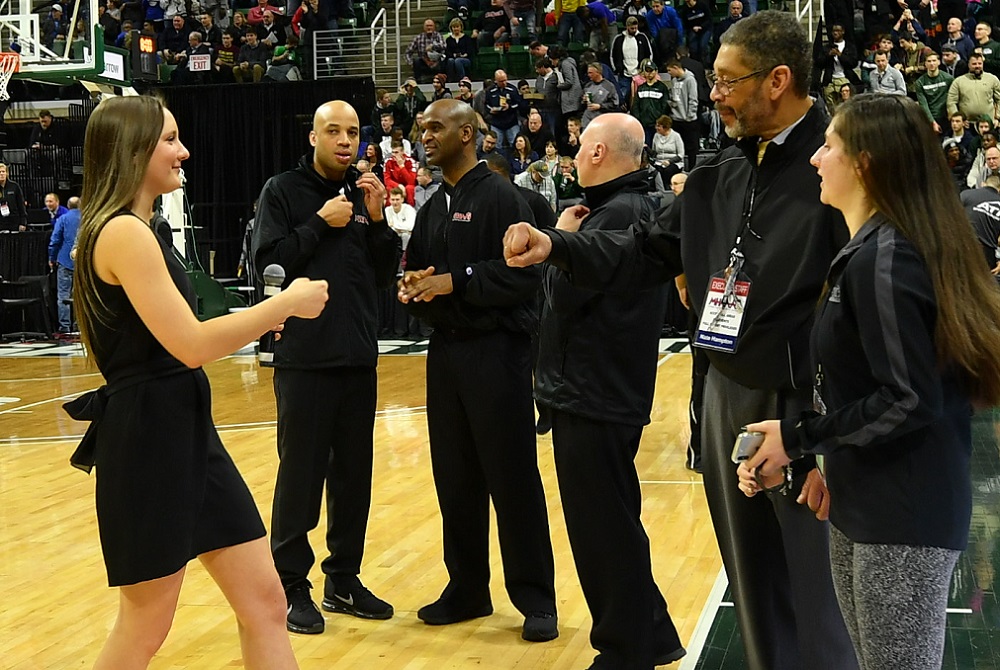
Study: Single-Sport Athletes Injured More
November 3, 2016
A study conducted by the University of Wisconsin School of Medicine and Public Health and funded by the National Federation of State High School Associations (NFHS) Foundation revealed that high school athletes who specialize in a single sport sustain lower-extremity injuries at significantly higher rates than athletes who do not specialize in one sport.
The study was conducted throughout the 2015-16 school year at 29 high schools in Wisconsin involving more than 1,500 student-athletes equally divided between male and female participants. The schools involved in the study represented a mixture of rural (14), suburban (12) and urban (3) areas, and enrollments were equally diverse with 10 small schools (less than 500 students), 10 medium schools (501-1,000 students) and nine large schools (more than 1,000 students).
Athletes who specialized in one sport were twice as likely to report previously sustaining a lower-extremity injury while participating in sports (46%) than athletes who did not specialize (24%). In addition, specialized athletes sustained 60 percent more new lower-extremity injuries during the study than athletes who did not specialize. Lower-extremity injuries were defined as any acute, gradual, recurrent or repetitive-use injury to the lower musculoskeletal system.
“While we have long believed that sport specialization by high school athletes leads to an increased risk of overuse injury, this study confirms those beliefs about the potential risks of sport specialization,” said Bob Gardner, NFHS executive director. “Coaches, parents and student-athletes need to be aware of the injury risks involved with an overemphasis in a single sport.”
Among those who reported previously sustaining a lower-extremity injury, the areas of the body injured most often were the ankle (43%) and knee (23%). The most common types of previous injuries were ligament sprains (51%) and muscle/tendon strains (20%).
New injuries during the year-long study occurred most often to the ankle (34%), knee (25%) and upper leg (13%), with the most common injuries being ligament sprains (41%), muscle/tendon strains (25%) and tendonitis (20%).
In addition, specialized athletes were twice as likely to sustain a gradual onset/repetitive-use injury than athletes who did not specialize, and those who specialized were more likely to sustain an injury even when controlling for gender, grade, previous injury status and sport.
Thirty-four (34) percent of the student-athletes involved in the Wisconsin study specialized in one sport, with females (41%) more likely to specialize than males (28%). Soccer had the highest level of specialization for both males (45%) and females (49%). After soccer, the rate of specialization for females was highest for softball (45%), volleyball (43%) and basketball (37%). The top specialization sports for males after soccer were basketball (37%), tennis (33%) and wrestling (29%).
The study, which was directed by Timothy McGuine, Ph.D., ATC, of the University of Wisconsin, also documented the effects of concurrent sport participation (participating in an interscholastic sport while simultaneously participating in an out-of-school club sport), which indicated further risk of athletes sustaining lower-extremity injuries.
Almost 50 percent of the student-athletes involved in the survey indicated they participated on a club team outside the school setting, and 15 percent of those individuals did so while simultaneously competing in a different sport within the school. Seventeen (17) percent of the student-athletes indicated that they took part in 60 or more primary sport competitions (school and club) in a single year. Among those student-athletes in this group who sustained new lower-extremity injuries during the year, 27 percent were athletes who specialized in one sport.
The student-athletes involved in the study were deemed “specialized” if they answered “yes” to at least four of the following six questions: 1) Do you train more than 75 percent of the time in your primary sport?; 2) Do you train to improve skill and miss time with friends as a result?; 3) Have you quit another sport to focus on one sport?; 4) Do you consider your primary sport more important than your other sports?; 5) Do you regularly travel out of state for your primary sport?; 6) Do you train more than eight months a year in your primary sport?
Although some sports (field hockey, lacrosse) are not offered in Wisconsin and were not included in the study, the study concluded that since specialization increased the risk of lower-extremity injuries in sports involved in the survey it would also likely increase the risk of injuries in sports that were not a part of the study.

MHSAA's Hampton Retires After Half-Century of School Sports Service
By
Geoff Kimmerly
MHSAA.com senior editor
July 30, 2021
Longtime assistant director Nate Hampton has retired after 32 years on staff with the Michigan High School Athletic Association and 50 serving in education and educational athletics.
After 18 years working in schools, Hampton began his tenure as part of the MHSAA staff on Sept. 5, 1989, and his impact has been felt across many sports and subjects over the decades. He has served as the MHSAA’s administrator for the majority of its most-played sports – football, girls and boys basketball and girls & boys track and field – as well as serving as staff liaison to the MHSAA Athletic Equity Committee and Upper Peninsula Athletic Committee.
His longtime guidance will continue to be felt nationally as well. Hampton served multiple terms on committees for the National Federation of State High School Associations (NFHS), including the football and basketball rules committees.
 “Nate has been a giant in high school athletics in Michigan over half a century and through eras that have seen the shaping of school sports as they’re played today,” MHSAA Executive Director Mark Uyl said. “The knowledge and leadership he’s provided locally, statewide and nationally has benefitted thousands of athletes and their families, both in how educational athletics are administered on the field and off.”
“Nate has been a giant in high school athletics in Michigan over half a century and through eras that have seen the shaping of school sports as they’re played today,” MHSAA Executive Director Mark Uyl said. “The knowledge and leadership he’s provided locally, statewide and nationally has benefitted thousands of athletes and their families, both in how educational athletics are administered on the field and off.”
Hampton received the Michigan High School Coaches Association’s Jack Johnson Distinguished Service Award in 2020 for his many contributions. He previously received a Citation from the NFHS in 2011 and also has been recognized by several other Michigan organizations including the Basketball Coaches Association of Michigan, Michigan Interscholastic Athletic Administrators Association and Michigan Interscholastic Track Coaches Association.
Hampton is a 1966 graduate of Detroit Eastern High School. He went on to earn his bachelor’s degree from Morgan State University (Md.) and a master’s from Eastern Michigan University.
Prior to joining the MHSAA staff, Hampton taught and coached one school year at Dearborn Heights Robichaud High School followed by 15 years total with the Highland Park School District where he coached three sports, taught and served as athletic director during his tenure. In 1987, Hampton began as supervisor of athletics and physical education for the Saginaw Public School District, where he was responsible for all phases of the athletic programs for both high schools, five middle schools and 24 elementary schools.
Hampton also served on the MHSAA Representative Council prior to joining the staff.
The majority of Hampton’s duties have been assumed by recently-hired assistant director William McKoy, who joined the staff earlier this month after previously serving as athletic director at Romulus Summit Academy North.
PHOTO: MHSAA assistant director Nate Hampton, second from right, thanks a national anthem soloist during the 2019 Boys Basketball Finals at Breslin Center.

